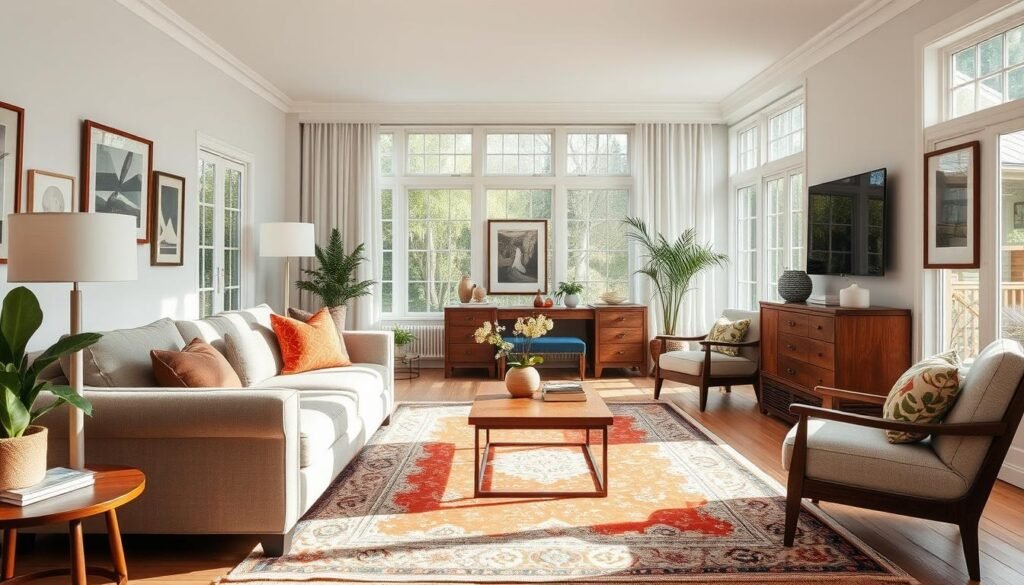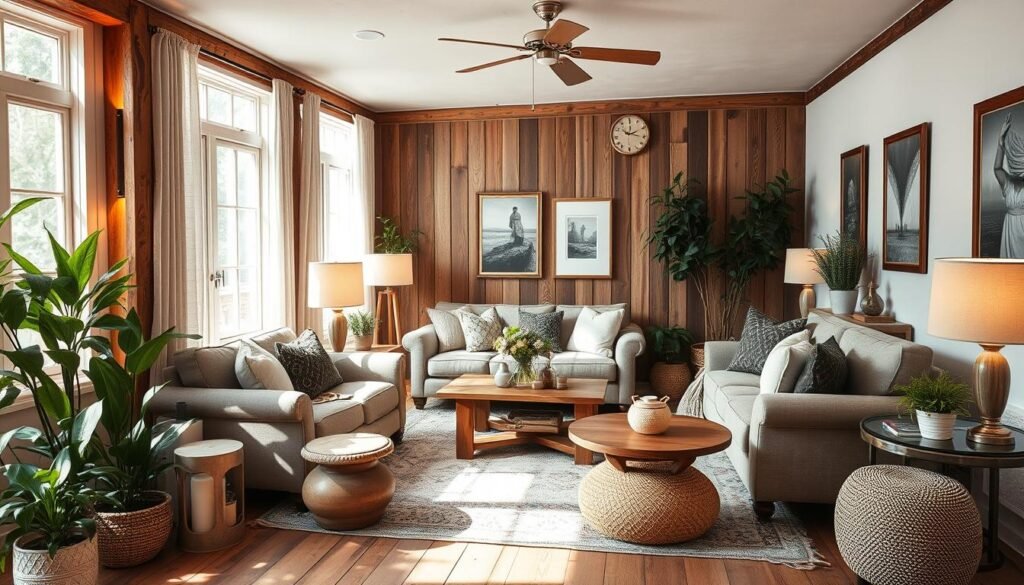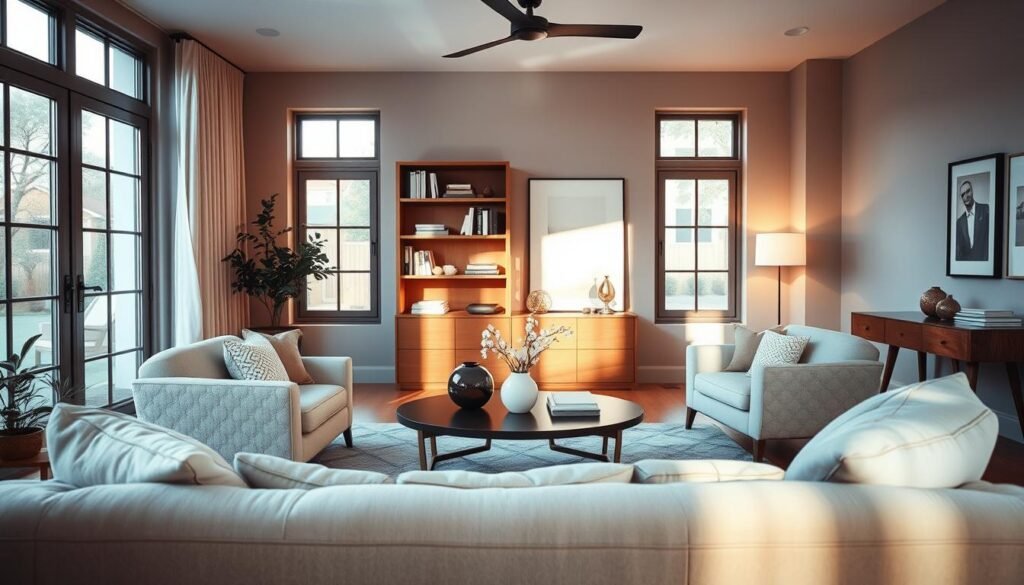Ever wonder why some rooms feel perfectly balanced while others seem cluttered or bland? The secret might lie in a timeless design principle borrowed from economics. Originally observed by Vilfredo Pareto, this concept reveals how a small portion of effort can create most of the impact—and it works wonders for styling spaces.
When applied to interior design, this strategy suggests focusing 80% of your space on a core style or color palette. The remaining 20% becomes your playground for bold accents or unexpected touches. Think neutral walls paired with vibrant artwork or a classic sofa dressed with eclectic throw pillows.
This approach solves a common dilemma: how to make rooms feel cohesive without sacrificing personality. By limiting standout pieces to a smaller portion of the space, you avoid visual overload while keeping things interesting. It’s like having a trusted recipe where most ingredients blend smoothly, but a pinch of spice makes the dish unforgettable.
Key Takeaways
- A century-old economic observation became a game-changer for stylish spaces
- Most rooms shine when 80% follows a unified theme
- Reserve 20% for eye-catching contrasts that reflect your personality
- Prevents spaces from feeling either too empty or too busy
- Simplifies decision-making for beginners and design enthusiasts alike
Discovering the 80-20 Rule in Interior Design
What if a century-old economic idea could transform your living space? This strategy began as a business productivity tool before becoming a cornerstone of stylish environments. Its magic lies in creating order while leaving room for self-expression.
Origins and Basic Principles
Vilfredo Pareto’s observation about resource distribution found new life in creative fields. In interior design, it translates to dedicating most elements to foundational choices. Think walls painted in calming neutrals or furniture with clean lines forming the backbone of your room.
The remaining portion becomes your signature space. This could mean bold geometric patterns on drapes or a cluster of vintage lamps. The principle works because it establishes visual anchors while preventing sensory overload.
Balancing Simplicity and Impact
Successful spaces walk the line between predictable and chaotic. A monochromatic bedroom gains energy from emerald-green throw blankets. An industrial loft softens its edges with plush area rugs. This balance lets each element shine without competing for attention.
| Approach | Focus | Visual Effect | Flexibility |
|---|---|---|---|
| Traditional 60-40 | Bolder accents | Dynamic but risky | Limited |
| 80-20 Method | Structured base | Harmonious | Highly adaptable |
| 50-50 Split | Equal emphasis | Competing elements | Challenging |
Your room’s size and natural light influence how you apply these ratios. Smaller spaces often benefit from stricter percentages, while sun-drenched rooms can handle more contrast. The goal remains constant: create harmony through thoughtful distribution of elements.
Practical Applications: home decor, 80 20 rule in decorating
Ready to transform your living area with this strategic approach? Let’s explore how to apply these concepts to key elements that shape your environment.

Furniture and Accessories
Start by selecting a dominant style for your larger items. A modern sectional could anchor your space, while a vintage velvet chair adds character. Keep 80% of your seating cohesive, then introduce one showstopping piece that sparks conversation.
Accessories follow similar logic. If botanical prints dominate your shelves, add metallic bookends for contrast. This creates rhythm without overwhelming the eye.
Lighting and Artwork
Layer your illumination like a pro. Use recessed lights for general brightness (80%), then hang a sculptural chandelier as your focal point. In galleries, group similar framed prints together, leaving space for one bold mixed-media piece that breaks the pattern.
Rugs, Textiles, and Color Schemes
Ground your room with a neutral jute rug covering most floorspace. Layer a smaller geometric-patterned mat near seating areas. For fabrics, choose linen curtains in your base color, then add throw pillows with unexpected textures.
Imagine walls painted soft sage (80%) accented by terracotta vases. This strategic color distribution creates calm while highlighting special pieces. The result? A space that feels both polished and personal.
Tips for Achieving a Balanced and Harmonious Space
How do top designers create rooms that feel both calm and captivating? The answer lies in strategic choices that honor your space’s natural features while adding thoughtful surprises. Let’s explore practical ways to build visual rhythm through intentional selections.

Selecting a Dominant Style and Color Palette
Begin by assessing your room’s architecture. Exposed beams might suggest farmhouse charm, while sleek lines could lean modern. Build your color scheme around neutrals like warm greige or soft ivory for walls and large furniture. These act as a blank canvas for personality-packed accents.
| Scheme Type | Color Relationship | Best For | Visual Impact |
|---|---|---|---|
| Complementary | Opposites on wheel | Dining areas, offices | Energetic & bold |
| Analogous | Neighbors on wheel | Bedrooms, lounges | Soothing & cohesive |
Incorporating Contrasting and Complementary Elements
Once your base feels settled, introduce contrast through materials and eras. Pair mid-century chairs with a raw-edge wood table. Drape chunky knit throws over smooth leather ottomans. This creates depth without clashing.
For color pops, try mustard cushions against slate sofas or teal artwork above sandy-toned consoles. Remember: your standout pieces should enhance the main style, not fight it. A single neon sign can energize a rustic den, while vintage maps add whimsy to contemporary studies.
Conclusion
Transform your living environment with a principle that champions both elegance and individuality. This design strategy streamlines decisions by highlighting elements that deliver maximum visual payoff.
By prioritizing quality over quantity, you invest in pieces that truly matter. Less clutter means more room for natural light to dance across surfaces, creating an inviting atmosphere that feels both fresh and functional.
Your space becomes a canvas for self-expression through curated accents. A vintage rug anchors modern furniture, while bold artwork injects energy into neutral schemes. These intentional choices reflect your story without overwhelming the senses.
This approach adapts seamlessly to any aesthetic preference. Whether blending rustic charm with industrial edges or mixing minimalist lines with textured fabrics, the foundation remains rooted in thoughtful proportion.
Embrace this method as your secret weapon for crafting interiors that balance calm with character. You’ll create rooms that feel intentionally designed yet effortlessly lived-in – where every element serves a purpose and sparks joy.

